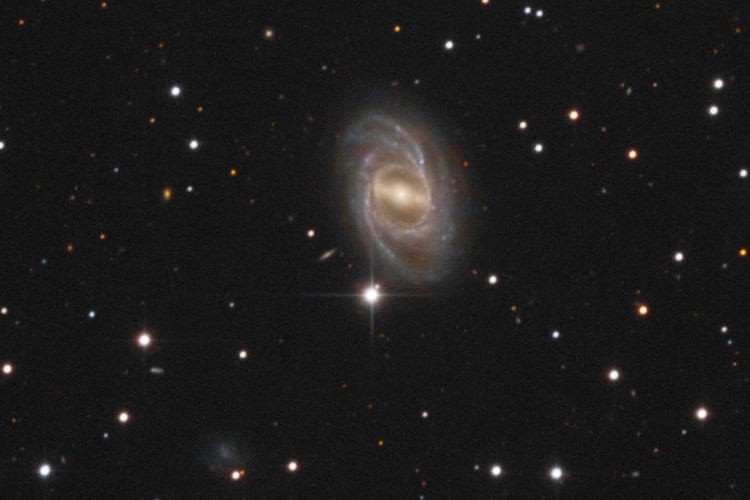Blog
IC 4703 is the diffuse emission nebula or HII region associated with Messier 16, which is actually a cluster of stars. It is the nebulous region surrounding Messier 16. These two objects make up the Eagle Nebula. They are relatively bright and are located in the constellation Serpens Cauda. This region contains the picturesque Pillars of Creation. This is an active star forming region 7,000 light years away. It is approximately magnitude 8. The cluster was discovered by De Cheseaux, but Messier later rediscovered it and remarked on its apparent nebulous appearance. The cluster is estimated to be 5.5 million years old, and the nebula would be a bit older. The nebula is about 55 x 70 light years. The Eagle Nebula lies in the Sagittarius Arm of the Milky Way.
more...George Benson (born March 22, 1943) is an American guitarist, singer, and songwriter. He began his professional career at the age of 21 as a jazz guitarist. Benson uses a rest-strokepicking technique similar to that of gypsy jazz players such as Django Reinhardt.
A former child prodigy, Benson first came to prominence in the 1960s, playing soul jazz with Jack McDuff and others. He then launched a successful solo career, alternating between jazz, pop, R&B singing, and scat singing. His album Breezin’ was certified triple-platinum, hitting no. 1 on the Billboard album chart in 1976. His concerts were well attended through the 1980s, and he still has a large following. Benson has been honored with a star on the Hollywood Walk of Fame.
Benson was born and raised in the Hill District in Pittsburgh, Pennsylvania. At the age of seven, he first played the ukulele in a corner drug store, for which he was paid a few dollars. At the age of eight, he played guitar in an unlicensed nightclub on Friday and Saturday nights, but the police soon closed the club down. At the age of 9, he started to record. Out of the four sides he cut, two were released: “She Makes Me Mad” backed with “It Should Have Been Me”, with RCA-Victor in New York; although one source indicates this record was released under the name “Little Georgie”, the 45rpm label is printed with the name George Benson. The single was produced by Leroy Kirkland for RCA’s rhythm and blues label, Groove Records. As he has stated in an interview, Benson’s introduction to showbusiness had an effect on his schooling. When this was discovered (tied with the failure of his single) his guitar was impounded. Luckily, after he spent time in a juvenile detention centre his stepfather made him a new guitar.
more...Fred Anderson (March 22, 1929 – June 24, 2010) was an American jazz tenor saxophonist who was based in Chicago, Illinois.[1] Anderson’s playing was rooted in the swing music and hard bop idioms, but he also incorporated innovations from free jazz, rendering him, as critics Ron Wynn and Joslyn Layne have written, “a seminal figure among Chicago musicians in the ’60s.”
Anderson was born Monroe, Louisiana. He grew up in the Southern United States and learned to play the saxophone by himself when he was a teenager.[3] Anderson moved his family to Evanston, Illinois in the 1940s. He studied music formally at the Roy Knapp Conservatory in Chicago, and had a private teacher for a short time. Fred worked installing carpet for decades to sustain his music and his family, before opening up a succession of important Chicago nightclubs. Despite Anderson’s prominence as an avant-garde musician, his guiding inspiration was Charlie Parker, portraits of whom are prominently displayed at Anderson’s club, the Velvet Lounge.
He was an important member of the Association for the Advancement of Creative Musicians (AACM). In the early 1960s Anderson formed his own group, playing his original compositions, with Vernon Thomas on drums, Bill Fletcher on bass, and his partner for many years, the Chicago jazz trumpeter Billy Brimfield.
Anderson appeared on several notable avant garde albums in the 1960s, notably the seminal Delmark recordings of saxophonist Joseph Jarman, As If It Were the Seasons (1968), and Song For (1966), which includes Anderson’s composition “Little Fox Run.”
https://www.youtube.com/watch?v=QCByTh-pxCc
more...Flamenco Fridays with Tangos
more...https://www.youtube.com/watch?v=A2xZsd6dWmQ
more...Arp 9/NGC 2523 is in Arp’s class for spiral galaxies with split arms. Arp’s comment reads: “Bifurcated arm does not start at end of bar”. In fact it has several arm segments not related to the bar. It is in Camelopardalis just above the northwest corner of Ursa Major. By redshift it is about 160 million light-years away though a single Sosies estimate says it is only about 93 million light-years away. If the 160 million light-year estimate is right the galaxy is very large, about 135,000 light-years across measuring its longest diameter out to the far reaches of it’s stars in my FITS data (174 arc seconds). But if the 93 million light-year figure is correct then it is 78,000 light-years across. I found nothing in the literature to explain the difference. In fact there’s little in the literature on the entire field. Apparently the far northern sky is poorly studied. For reasons explained below I will go with the redshift distance estimate being most accurate. In fact it may be slightly shy of its distance.
Arp 9 is classed as SB®bc by NED and SBb I by the NGC project. Most of what I found on this one in the literature was descriptive telling me little I couldn’t see in my image. Notes like: “The nucleus and bar are still strong, but the ring is narrower and knotty. Two main spiral arms, narrow and knotty (one with branching) emerge from the ring near the extremities of the bar. Additional, weaker arms start near the minor axis of the elliptical ring (here appearing circular). Note the slight asymmetry.” aren’t very helpful.
There’s little on the rest of the field. The edge on spiral to the west (right) is NGC 2523B. It too is at a redshift distance of 177 million light-years. If correct that makes it about 100,000 light-years across. About the same as our galaxy but larger than the majority of spiral galaxies. I found no other distance estimates for it. It is classed as SA(s)b: by NED. Most papers consider it a companion of Arp 9 though one referred to the very diffuse galaxy south of Arp 9 that is seen at the bottom of the cropped image as a companion. It is MAILYAN 026 which refers to the Mailyan Dwarf Galaxy Catalogue. I found nothing useful on it. If it is 160 million light-years away then it is 27,000 light-years across. If the 93 million light-years is right then it is 16 million light-years across. The larger figure seems more reasonable for its brightness as most dwarfs of the smaller size are so faint I’d not likely see it at that distance. To its east (left) is what appears to be a short asteroid trail. It shows in the DSS images and all my subs so is not an asteroid but a distant edge on galaxy. Really a weird object. Unfortunately, neither NED nor SIMBAD show anything at that position. But then the vast majority of the galaxies in the image are anonymous.
more...Otis Spann (March 21, 1924 or 1930 – April 24, 1970) was an American blues musician, whom many consider to be the leading postwar Chicago blues pianist.
Spann’s father was, according to some sources, a pianist called Friday Ford. His mother, Josephine Erby, was a guitarist who had worked with Memphis Minnie and Bessie Smith, and his stepfather, Frank Houston Spann, was a preacher and musician. One of five children, Spann began playing the piano at the age of seven, with some instruction from Friday Ford, Frank Spann, and Little Brother Montgomery.
By the age of 14, he was playing in bands in the Jackson area. He moved to Chicago in 1946, where he was mentored by Big Maceo Merriweather. Spann performed as a solo act and with the guitarist Morris Pejoe, working a regular spot at the Tic Toc Lounge.[3] Spann became known for his distinctive piano style. He replaced Merriweather as Muddy Waters’s piano player in late 1952 and participated in his first recording session with the band on September 24, 1953. He continued to record as a solo artist and session player with other musicians, including Bo Diddley and Howlin’ Wolf, during his tenure with the group. He stayed with Waters until 1968.
more...Eddie James “Son” House, Jr. (March 21, 1902 – October 19, 1988) was an American delta blues singer and guitarist, noted for his highly emotional style of singing and slide guitarplaying.
After years of hostility to secular music, as a preacher and for a few years also as a church pastor, he turned to blues performance at the age of 25. He quickly developed a unique style by applying the rhythmic drive, vocal power and emotional intensity of his preaching to the newly learned idiom. In a short career interrupted by a spell in Parchman Farm penitentiary, he developed to the point that Charley Patton, the foremost blues artist of the Mississippi Delta region, invited him to share engagements and to accompany him to a 1930 recording session for Paramount Records.
Issued at the start of the Great Depression, the records did not sell and did not lead to national recognition. Locally, House remained popular, and in the 1930s, together with Patton’s associate Willie Brown, he was the leading musician of Coahoma County. There he was a formative influence on Robert Johnson and Muddy Waters. In 1941 and 1942, House and the members of his band were recorded by Alan Lomax and John W. Work for the Library of Congress and Fisk University. The following year, he left the Delta for Rochester, New York, and gave up music.
In 1964, a group of young record collectors discovered House, whom they knew of from his records issued by Paramount and by the Library of Congress. With their encouragement, he relearned his repertoire and established a career as an entertainer, performing for young, mostly white audiences in coffeehouses, at folk festivals and on concert tours during the American folk music revival, billed as a “folk blues” singer. He recorded several albums, and some informally taped concerts have also been issued as albums. House died in 1988.
In addition to his early influence on Robert Johnson and Muddy Waters, he was an inspiration to John Hammond, Alan Wilson (of Canned Heat), Bonnie Raitt, the White Stripes, Dallas Green and John Mooney.
In 2017, his single, “Preachin’ the Blues” was inducted in to the Blues Hall of Fame.
House was born in the hamlet of Lyon, north of Clarksdale, Mississippi, the second of three brothers, and lived in the rural Mississippi Delta until his parents separated, when he was about seven or eight years old.
more...Johann Sebastian Bach (31 March [O.S. 21 March] 1685 – 28 July 1750) was a German composer and musician of the Baroque period. He is known for instrumental compositions such as the Art of Fugue, the Brandenburg Concertos, and the Goldberg Variations as well as for vocal music such as the St Matthew Passion and the Mass in B minor. Since the 19th-century Bach Revival he has been generally regarded as one of the greatest composers of all time.
The Bach family already counted several composers when Johann Sebastian was born as the last child of a city musician in Eisenach. After becoming an orphan at age 10, he lived for five years with his eldest brother Johann Christoph Bach, after which he continued his musical development in Lüneburg. From 1703 he was back in Thuringia, working as a musician for Protestant churches in Arnstadt and Mühlhausen and, for longer stretches of time, at courts in Weimar—where he expanded his repertoire for the organ—and Köthen—where he was mostly engaged with chamber music. From 1723 he was employed as Thomaskantor (cantor at St. Thomas) in Leipzig. He composed music for the principal Lutheran churches of the city, and for its university’s student ensemble Collegium Musicum. From 1726 he published some of his keyboard and organ music. In Leipzig, as had happened in some of his earlier positions, he had a difficult relation with his employer, a situation that was little remedied when he was granted the title of court composer by King Augustus III of Poland in 1736. In the last decades of his life he reworked and extended many of his earlier compositions. He died of complications after eye surgery in 1750.
Bach enriched established German styles through his mastery of counterpoint, harmonic and motivic organisation, and his adaptation of rhythms, forms, and textures from abroad, particularly from Italy and France. Bach’s compositions include hundreds of cantatas, both sacred and secular.[4] He composed Latin church music, Passions, oratorios, and motets. He often adopted Lutheran hymns, not only in his larger vocal works, but for instance also in his four-part chorales and his sacred songs. He wrote extensively for organ and for other keyboard instruments. He composed concertos, for instance for violin and for harpsichord, and suites, as chamber music as well as for orchestra. Many of his works employ the genres of canon and fugue.
Throughout the 18th century Bach was mostly renowned as an organist, while his keyboard music, such as The Well-Tempered Clavier, was appreciated for its didactic qualities. The 19th century saw the publication of some major Bach biographies, and by the end of that century all of his known music had been printed. Dissemination of scholarship on the composer continued through periodicals and websites exclusively devoted to him, and other publications such as the Bach-Werke-Verzeichnis (BWV, a numbered catalogue of his works) and new critical editions of his compositions. His music was further popularised through a multitude of arrangements, including for instance the Air on the G String, and of recordings, for instance three different box sets with complete performances of the composer’s works marking the 250th anniversary of his death.
more...Happy International Day of Happiness 2019
What is the International Day of Happiness? It’s a day to be happy, of course! Since 2013, the United Nations has celebrated the International Day of Happiness as a way to recognise the importance of happiness in the lives of people around the world. In 2015, the UN launched the 17 Sustainable Development Goals that seek to end poverty, reduce inequality, and protect our planet – three key aspects that lead to well-being and happiness. Last year, the Smurfs rallied behind the 17 Sustainable Development Goals for the International Day of Happiness.
The United Nations invites each person of any age, plus every classroom, business and government to join in celebration of the International Day of Happiness.
more...NGC 1491 is a bright nebula in the constellation of Perseus. It is also known as LBN 704. 
Charles W. Thompson, who became known as Maxwell Street Jimmy Davis (March 2, 1925 – December 28, 1995) was an American electric blues singer, guitarist and songwriter. He played with John Lee Hooker, recorded an album for Elektra Records in the mid-1960s, and remained a regular street musician on Maxwell Street, in Chicago, for over 40 years.[2] He is best remembered for his songs “Cold Hands” and “4th and Broad”.He was also known as Jewtown Jimmy.
more...Harold Mabern, Jr. (born March 20, 1936) is an American jazz pianist and composer, principally in the hard bop, post-bop, and soul jazz fields. He is described in The Penguin Guide to Jazz Recordings as “one of the great post-bop pianists”.
Mabern learned orchestration techniques from Bill Lee, and comping and chord voicing from pianists Chris Anderson and Billy Wallace.
more...Margaret Marian McPartland, OBE (née Turner; 20 March 1918 – 20 August 2013), was an English-American jazz pianist, composer and writer. She was the host of Marian McPartland’s Piano Jazz on National Public Radio from 1978 to 2011.
After her marriage to trumpeter Jimmy McPartland in February 1945, she resided in the United States when not travelling throughout the world to perform. In 1969 she founded Halcyon Records, a recording company that produced albums for 10 years. In 2000 she was named a National Endowment for the Arts Jazz Master. In 2004 she was given a Grammy Award for lifetime achievement. In 2007 she was inducted into the National Radio Hall of Fame. Although known mostly for jazz, she composed other types of music as well, performing her own symphonic work A Portrait of Rachel Carson with the University of South Carolina Symphony Orchestra in 2007. In 2010 she was named a member of the Order of the British Empire.
Margaret Marian Turner was born on 20 March 1918 to Frank and Janet (née Payne) Turner. She had one younger sibling, a sister, Joyce. She demonstrated early aptitude at the piano, and would later realize that she had perfect pitch. Margaret (Maggie to her family) studied violin from the age of nine, but never took to the instrument. She also trained as a vocalist and received a number of favorable reviews in the local paper. Janet refused to find her daughter a piano teacher until the age of 16, by which time Margaret was already adept at learning songs by ear. This lack of early education meant that Marian was never a strong reader of notated music, and would always prefer to learn through listening.
more...What are those strange arcs? While imaging the cluster of galaxies Abell 370, astronomers noticed an unusual arc. The arc wasn’t understood right away — not until better images showed that the arc was a previously unseen type of astrophysical artifact of a gravitational lens, where the lens was the center of an entire cluster of galaxies. Today, we know that this arc, the brightest arc in the cluster, actually consists of two distorted images of a fairly normal galaxy that happens to lie far in the distance. Abell 370’s gravity caused the background galaxies’ light — and others — to spread out and come to the observer along multiple paths, not unlike a distant light appears through the stem of a wine glass. Almost all of the yellow images featured here are galaxies in the Abell 370 cluster. An astute eye can pick up many strange arcs and distorted arclets, however, that are actually gravitationally lensed images of distant normal galaxies. Studying Abell 370 and its images gives astronomers a unique window into the distribution of normal and dark matter in galaxy clusters and the universe.
more...More Posts
- What Happened to Mayday?
- The Cosmos with NGC 3898
- Barrington Levy
- Coke Escovedo
- Percy Heath
- Dick Twardzik
- Frankie Lee Sims
- Flamenco Fridays con Vicente Amigo
- Daily Roots with Vivian Jones
- The Cosmos with NGC 3310
- Willie Nelson
- Ray Baretto
- Toots Thielemans
- Duke Ellington
- World Music with Sinikka Langeland
- Daily Roots with Yabby You
- The Cosmos with PN G054.2-03.4
- John Tchicai
- Mario Bauzá
- Charley Patton




